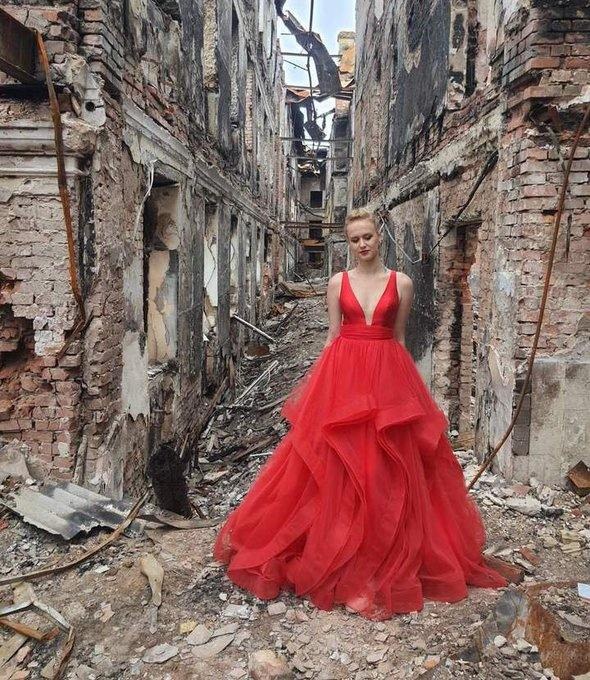
A young woman, reportedly a high school graduate in Kharkiv, Ukraine, stands in front of what is said to be her bombed-out high school.
While life moved on for most of us, the 2014 war — and given the body count, it was a war no matter what it was labeled in the political realm — never really stopped. Rather it ground forward to the current brutality while most of the world wasn’t looking. Like gun violence, like COVID, like environmental crisis, like so many humanitarian crises around the world — our attention fades while the reality grinds on and, often, worsens.
Apologies for what might seem a glib connection, but when I think about our limited capacity to stay with the news, I’m reminded of a line an editor friend used once when he spoke to a group of PR folks: “Let me know if you’re done listening before I’m done talking.”
Emotional versus factual truth
Most of my Ukraine-related art shares are passed along with due credit but no commentary. People can read what they want into the art itself, but to me they echo the emotion and deep beauty of the place — a beauty that sometimes could be hard to see amid political and economic ruin, but is there in the fields and flowers of the country, the embroidery and garlands on traditional costumes, the ornate curves of half-restored buildings. I still remember the first time I understood why Kyiv was considered the Paris of Eastern Europe.
That may be why I was so taken by the photo above when it came across my feed a couple of weeks ago. A young woman in billows of red gauze — her graduation gown, the caption said — posed in front of the rubble that once was her high school in Kharkiv. Much has been written about the resilience of the Ukrainian people in the face of Russian aggression. This photo, in one striking image, tells that story of resiliency. No surprise that it soon went viral.
So I did the rare thing and hit SHARE. I fretted a bit about whether I had committed that digital-era sin and passed along a fake. I don’t pretend to possess svvy online fact-checking skills. But my doubts were enough to make me do a bit more hunting. Sure enough, a Twitter stream argued back-and-forth whether this was legit. Others pushed back with links to Business Ukraine Magazine and The Telegraph, which cited the original source as the young woman’s aunt.
I let the photo ride. Sometimes an image, like a story, holds an emotional truth that speaks to us like art.
At the same time, I know the risks of a news site — or individual journalist — presenting something as entirely factual that may not be in the literal sense. In the realm of narrative, whether via words or images, we need to guard our credibility. Photos may only capture a single scene or moment of a larger situation, but they should not be altered. Written stories can frame and focus, but must not conflate or mislead.
Yet I went back again and again to that photo. I have not shied away from the photos of the devastation and human despair, but I was drawn to another story about Ukraine. Call it resilience. Call it defiance. Hell, call it an F-you from Ukraine to Putin.
A photographer’s perspective
Then I saw it posted on the feed of John Doman, a former colleague, longtime friend and thoughtful photographer. Doman and I worked together for a time at the St. Paul, Minnesota, Pioneer Press. We spent three weeks together with the Kurds at hospitals and refugee camps in Iraq and Turkey after the first Persian Gulf War. We both reported — me with a notebook, him a camera — on countless stories close to home, from weather to sports to personal tragedy. I never doubted that he would make me better and more aware. Before St. Paul, Doman was a photographer at the Miami Herald, sent into far deadlier zones than I had ever experienced.
He’s retired now. When I saw his share of that photo, I told him about my quandary and asked what he knew of its provenance. Here’s how he replied:
The photograph of the Ukrainian teenager in her graduation gown tells the sad story of this horrid war better than almost all the more traditional photojournalism produced in the past months. It is evocative and tells something straightforward in one single frame. A difficult thing to do.
It’s not traditional photojournalism — it’s something more. It goes beyond reportage and illustrates a definite point-of-view. This gem of a photograph works. Of all the heart breaking war photos I’ve seen produced in this bloodied country, this frame grabbed me the hardest. A poor lovely child — so close to the rest of her life — and it is all being taken away from her. Taken by powers far away, for reasons unknowable. It illustrates war in the present and the question of how it will affect the Ukrainian people of the future.
One more thing from a photographic point of view: The use of the bright red dress juxtaposed upon the gray ruins of her school is perfect. The framing and composition is right on. This photograph was produced by a thinking photographer with vision.


